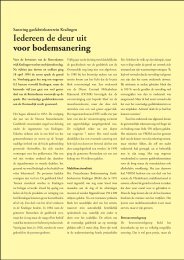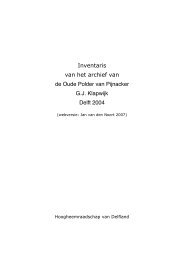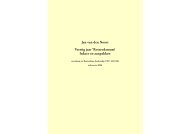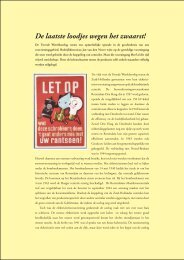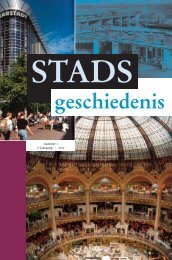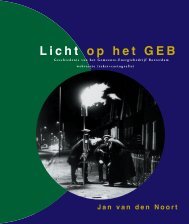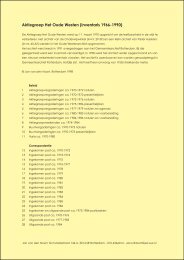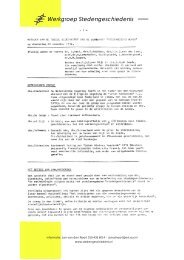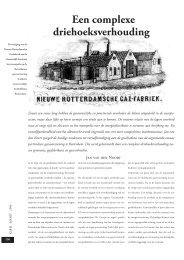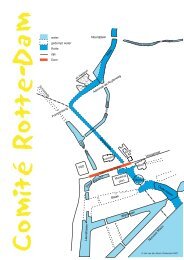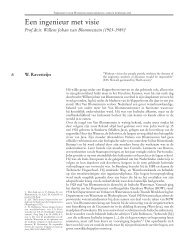Net Werk voor de Geschiedenis van Hygiene en Milieu, 1999-2001 ...
Net Werk voor de Geschiedenis van Hygiene en Milieu, 1999-2001 ...
Net Werk voor de Geschiedenis van Hygiene en Milieu, 1999-2001 ...
Create successful ePaper yourself
Turn your PDF publications into a flip-book with our unique Google optimized e-Paper software.
20<br />
21<br />
workings of our cultural s<strong>en</strong>sibilities.<br />
The book explores how the nature<br />
of zoos and their significance<br />
to cultural consumers is portrayed<br />
in over 100 works. It explores what<br />
animals’ captivity signifies about the<br />
people who create, maintain, and<br />
patronize zoos; Malamud argues<br />
that zoos repres<strong>en</strong>t a cultural danger,<br />
a <strong>de</strong>a<strong>de</strong>ning of our s<strong>en</strong>sibilities,<br />
because the institutions - rather<br />
than fostering an appreciation for<br />
animals’ attributes - convince spectators<br />
that people are the imperial<br />
species.”<br />
Merrett, S., Introduction to the economics<br />
of water resources: an international<br />
perspective, (Lanham:<br />
Rowman and Littlefield, 1997).<br />
Niklasson, M., D<strong>en</strong>droecological<br />
studies In forest and fire history.<br />
(dissertatie Sveriges Lantbruksuniversitet<br />
1998.<br />
“D<strong>en</strong>droecological methods were<br />
used to investigate past Saami use<br />
of forest resources and to reconstruct<br />
temporal and spatial aspects<br />
of fire disturbances including successional<br />
patterns. (I) in the first<br />
study, seasonal and annual patterns<br />
in Saami use of innerbark for food<br />
were reconstructed from the early<br />
1600s to 1870 with cross-dating of<br />
bark peeling scars in scots pine. The<br />
regular use of inner bark over time<br />
and the lack of association with<br />
known agrarian famine years, support<br />
the hypothesis that inner bark<br />
was used regularly, and not only as<br />
an emerg<strong>en</strong>cy food. Spatial changes<br />
peeling activity around the lake is<br />
interpreted as temporal changes in<br />
nomadic fishing activity. (II) in a<br />
600 km 2 landscape in Vasterbott<strong>en</strong><br />
county, samples from stumps, <strong>de</strong>ad<br />
trees and living trees with fire scars<br />
were collected for a spatial reconstruction<br />
of fires back to the 1300s.<br />
Up to the late 1600s fires were<br />
relatively few but large. During the<br />
agricultural colonization of the area,<br />
from 1650 to 1850, the number of<br />
fires increased eighte<strong>en</strong>-fold but the<br />
fire frequ<strong>en</strong>cy increased only fourfold<br />
due to a parallel <strong>de</strong>crease in fire<br />
size. (III) the long-term influ<strong>en</strong>ce<br />
of fires and fire int<strong>en</strong>sity on the<br />
tree species composition in a mixed<br />
pinus-picea forest was investigated<br />
with tree-ring methods which were<br />
combined with a poll<strong>en</strong> and charcoal<br />
analysis of a peat hollow. Fire<br />
history was dated with fire scars in<br />
snags and trees and was successfully<br />
correlated to a charcoal layer<br />
in peat. Age structures and growth<br />
reactions in trees after fire revealed,<br />
in combination with poll<strong>en</strong> analysis,<br />
that fire int<strong>en</strong>sity was an important<br />
factor for the tree species<br />
dynamics and post-fire successional<br />
patterns. (IV) in a fourth study,<br />
age <strong>de</strong>termination of suppressed<br />
slow-growing Norway spruce was<br />
greatly improved with an alternative<br />
tree-ring dating method. This improved<br />
the age <strong>de</strong>termination with<br />
64<br />
contactblad <strong>van</strong> <strong>de</strong><br />
stichting net werk <strong>voor</strong> <strong>de</strong><br />
950-951<br />
geschie<strong>de</strong>nis <strong>van</strong> hygiëne <strong>en</strong> milieu<br />
redactie: myriam d a r u<br />
webversie: jan <strong>van</strong> <strong>de</strong>n n o o r t<br />
21<br />
22<br />
20 years (on average) compared to<br />
ring counts in cores. The large discrepancy<br />
in age was due to missing<br />
rings in the lower stem part and the<br />
initiation of a new root collar above<br />
the initial point of origin. It is conclu<strong>de</strong>d<br />
that tree-ring analysis can<br />
contribute ess<strong>en</strong>tial data to forest<br />
and fire history. In many contexts,<br />
tree rings may be the only available<br />
source of information and provi<strong>de</strong>s<br />
new insight to natural processes as<br />
well as human impact and use of<br />
forest resources.”<br />
Pfister, C. Wetternachhersage. 500<br />
Jahre Klimavariation<strong>en</strong> und<br />
Naturkatastroph<strong>en</strong> (1496-1995),<br />
H. Grassl, J. Lüterbacher <strong>en</strong><br />
H. Wanner (Bern: Paul Haupt,<br />
<strong>1999</strong>).<br />
“Including 97 colored graphs, 38<br />
pictures, 85 diagrams of ‘Grosswetterlag<strong>en</strong>’<br />
and 195 historical charts<br />
of mean monthly sea level pressure<br />
in Europe from the early sixte<strong>en</strong>th<br />
c<strong>en</strong>tury to the pres<strong>en</strong>t. Results of<br />
first-ever investigations betwe<strong>en</strong> the<br />
relationship of climatic variations<br />
in the past and the frequ<strong>en</strong>cy and<br />
severity of natural hazards in c<strong>en</strong>tral<br />
Europe during the last five-hundred<br />
years are pres<strong>en</strong>ted in this book.<br />
The manner in which monthly<br />
temperature and precipitation are<br />
estimated from docum<strong>en</strong>tary data<br />
prior to the period of instrum<strong>en</strong>tal<br />
measurem<strong>en</strong>ts is <strong>de</strong>scribed in the<br />
first section. A second focus is put<br />
on reconstructing natural hazards<br />
- severe floods, storms and damaging<br />
avalanches - from docum<strong>en</strong>tary<br />
data. The frequ<strong>en</strong>cy of such ev<strong>en</strong>ts<br />
is analyzed and the most extreme<br />
of them are <strong>de</strong>scribed in <strong>de</strong>tail. It<br />
is conclu<strong>de</strong>d that in a quasi-natural<br />
climate the frequ<strong>en</strong>cy of natural<br />
hazards un<strong>de</strong>rgoes large variations.<br />
As a consequ<strong>en</strong>ce, the tw<strong>en</strong>tieth<br />
c<strong>en</strong>tury cannot be tak<strong>en</strong> as a safe<br />
basis for extrapolations into the<br />
future or the diagnosis of anthropog<strong>en</strong>ic<br />
effects. In a final chapter, the<br />
significance of the findings for the<br />
curr<strong>en</strong>t <strong>de</strong>bate on climate is highlighted.”<br />
Poppel, F. W. A. <strong>van</strong>, De ‘statistieke<br />
ontleding <strong>van</strong> <strong>de</strong> doo<strong>de</strong>n’: e<strong>en</strong><br />
spraakzame bron, (Nijmeg<strong>en</strong>:<br />
KU Nijmeg<strong>en</strong>, <strong>1999</strong>), ISBN 90<br />
5710 064 9.<br />
Ribeiro, L. F., The cultural landscape<br />
and the uniqu<strong>en</strong>ess of<br />
place: a gre<strong>en</strong>way heritage network<br />
for landscape conservation<br />
of Lisbon metropolitan area,<br />
PhD University of Massachusetts<br />
(1998).<br />
“The cultural landscape of Lisbon<br />
metropolitan area evolved through<br />
processes of trial and error, and cultural<br />
exchanges, leading to a landscape<br />
that is in many situations ecologically<br />
sustainable, visual attractive,<br />
and culturally and historically<br />
i<strong>de</strong>ntifiable. This results in a high<br />
landscape quality that is un<strong>de</strong>rly-<br />
20/21<br />
<strong>Net</strong> <strong>Werk</strong> 64 - juni <strong>1999</strong><br />
21/22



